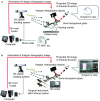Real-time in situ three-dimensional integral videography and surgical navigation using augmented reality: a pilot study
- PMID: 23703710
- PMCID: PMC3707071
- DOI: 10.1038/ijos.2013.26
Real-time in situ three-dimensional integral videography and surgical navigation using augmented reality: a pilot study
Abstract
To evaluate the feasibility and accuracy of a three-dimensional augmented reality system incorporating integral videography for imaging oral and maxillofacial regions, based on preoperative computed tomography data. Three-dimensional surface models of the jawbones, based on the computed tomography data, were used to create the integral videography images of a subject's maxillofacial area. The three-dimensional augmented reality system (integral videography display, computed tomography, a position tracker and a computer) was used to generate a three-dimensional overlay that was projected on the surgical site via a half-silvered mirror. Thereafter, a feasibility study was performed on a volunteer. The accuracy of this system was verified on a solid model while simulating bone resection. Positional registration was attained by identifying and tracking the patient/surgical instrument's position. Thus, integral videography images of jawbones, teeth and the surgical tool were superimposed in the correct position. Stereoscopic images viewed from various angles were accurately displayed. Change in the viewing angle did not negatively affect the surgeon's ability to simultaneously observe the three-dimensional images and the patient, without special glasses. The difference in three-dimensional position of each measuring point on the solid model and augmented reality navigation was almost negligible (<1 mm); this indicates that the system was highly accurate. This augmented reality system was highly accurate and effective for surgical navigation and for overlaying a three-dimensional computed tomography image on a patient's surgical area, enabling the surgeon to understand the positional relationship between the preoperative image and the actual surgical site, with the naked eye.
Figures


Similar articles
-
Vision-based markerless registration using stereo vision and an augmented reality surgical navigation system: a pilot study.BMC Med Imaging. 2015 Nov 2;15:51. doi: 10.1186/s12880-015-0089-5. BMC Med Imaging. 2015. PMID: 26525142 Free PMC article.
-
Augmented reality as an aid in maxillofacial surgery: validation of a wearable system allowing maxillary repositioning.J Craniomaxillofac Surg. 2014 Dec;42(8):1970-6. doi: 10.1016/j.jcms.2014.09.001. Epub 2014 Sep 11. J Craniomaxillofac Surg. 2014. PMID: 25441867
-
3-D augmented reality for MRI-guided surgery using integral videography autostereoscopic image overlay.IEEE Trans Biomed Eng. 2010 Jun;57(6):1476-86. doi: 10.1109/TBME.2010.2040278. Epub 2010 Feb 17. IEEE Trans Biomed Eng. 2010. PMID: 20172791
-
3D Visualization and Augmented Reality for Orthopedics.Adv Exp Med Biol. 2018;1093:193-205. doi: 10.1007/978-981-13-1396-7_16. Adv Exp Med Biol. 2018. PMID: 30306483 Review.
-
Stereotactic navigation in oral and maxillofacial surgery.Br J Oral Maxillofac Surg. 2010 Mar;48(2):79-83. doi: 10.1016/j.bjoms.2009.04.037. Epub 2010 Jan 12. Br J Oral Maxillofac Surg. 2010. PMID: 20061072 Review.
Cited by
-
Augmented reality-guided positioning system for radiotherapy patients.J Appl Clin Med Phys. 2022 Mar;23(3):e13516. doi: 10.1002/acm2.13516. Epub 2022 Jan 5. J Appl Clin Med Phys. 2022. PMID: 34985188 Free PMC article.
-
Application of holography and augmented reality based technology to visualize the internal structure of the dental root - a proof of concept.Head Face Med. 2022 Apr 5;18(1):12. doi: 10.1186/s13005-022-00307-4. Head Face Med. 2022. PMID: 35382839 Free PMC article.
-
Augmented reality (AR) and virtual reality (VR) applied in dentistry.Kaohsiung J Med Sci. 2018 Apr;34(4):243-248. doi: 10.1016/j.kjms.2018.01.009. Kaohsiung J Med Sci. 2018. PMID: 29655414 Free PMC article. Review.
-
A Skin-Conformal, Stretchable, and Breathable Fiducial Marker Patch for Surgical Navigation Systems.Micromachines (Basel). 2020 Feb 13;11(2):194. doi: 10.3390/mi11020194. Micromachines (Basel). 2020. PMID: 32070015 Free PMC article.
-
Effect of marker position and size on the registration accuracy of HoloLens in a non-clinical setting with implications for high-precision surgical tasks.Int J Comput Assist Radiol Surg. 2021 Jun;16(6):955-966. doi: 10.1007/s11548-021-02354-9. Epub 2021 Apr 15. Int J Comput Assist Radiol Surg. 2021. PMID: 33856643 Free PMC article.
References
-
- Casap N, Wexler A, Elisha R. Computerized navigation for surgery of the lower jaw: comparison of 2 navigation systems. J Oral Maxillofac Surg. 2008;66 7:1467–1475. - PubMed
-
- Nijmeh AD, Goodger NM, Hawkes D, et al. Image-guided navigation in oral and maxillofacial surgery. Br J Oral Maxillofac Surg. 2005;43 4:294–302. - PubMed
-
- Tran HH, Suenaga H, Kuwana K, et al. Augmented reality system for oral surgery using 3D auto stereoscopic visualization. Med Image Comput Assist Interv. 2011;14 Pt 1:81–88. - PubMed
-
- Lubbers HT, Matthews F, Damerau G, et al. No plane is the best one-the volume is! Oral Surg Oral Med Oral Pathol Oral Radiol Endod. 2011;113 3:421. - PubMed
-
- Traub J, Sielhorst T, Heining SM, et al. Advanced display and visualization concepts for image guided surgery. J Display Technol. 2008;4 4:483–490.
Publication types
MeSH terms
LinkOut - more resources
Full Text Sources
Other Literature Sources

